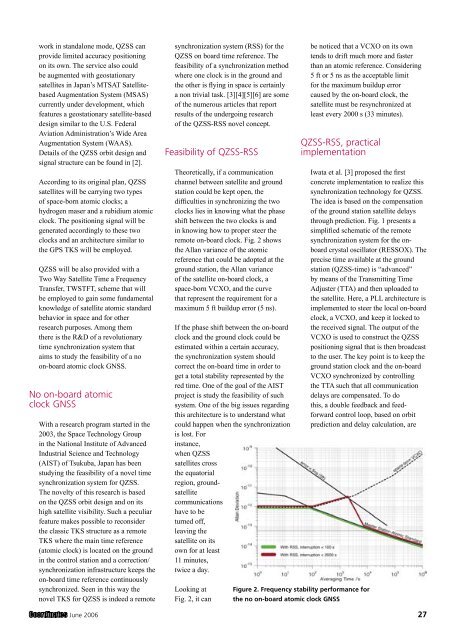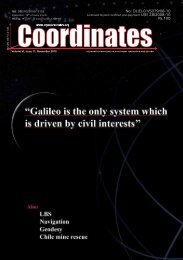Download - Coordinates
Download - Coordinates
Download - Coordinates
You also want an ePaper? Increase the reach of your titles
YUMPU automatically turns print PDFs into web optimized ePapers that Google loves.
work in standalone mode, QZSS can<br />
provide limited accuracy positioning<br />
on its own. The service also could<br />
be augmented with geostationary<br />
satellites in Japan’s MTSAT Satellitebased<br />
Augmentation System (MSAS)<br />
currently under development, which<br />
features a geostationary satellite-based<br />
design similar to the U.S. Federal<br />
Aviation Administration’s Wide Area<br />
Augmentation System (WAAS).<br />
Details of the QZSS orbit design and<br />
signal structure can be found in [2].<br />
According to its original plan, QZSS<br />
satellites will be carrying two types<br />
of space-born atomic clocks; a<br />
hydrogen maser and a rubidium atomic<br />
clock. The positioning signal will be<br />
generated accordingly to these two<br />
clocks and an architecture similar to<br />
the GPS TKS will be employed.<br />
QZSS will be also provided with a<br />
Two Way Satellite Time a Frequency<br />
Transfer, TWSTFT, scheme that will<br />
be employed to gain some fundamental<br />
knowledge of satellite atomic standard<br />
behavior in space and for other<br />
research purposes. Among them<br />
there is the R&D of a revolutionary<br />
time synchronization system that<br />
aims to study the feasibility of a no<br />
on-board atomic clock GNSS.<br />
No on-board atomic<br />
clock GNSS<br />
With a research program started in the<br />
2003, the Space Technology Group<br />
in the National Institute of Advanced<br />
Industrial Science and Technology<br />
(AIST) of Tsukuba, Japan has been<br />
studying the feasibility of a novel time<br />
synchronization system for QZSS.<br />
The novelty of this research is based<br />
on the QZSS orbit design and on its<br />
high satellite visibility. Such a peculiar<br />
feature makes possible to reconsider<br />
the classic TKS structure as a remote<br />
TKS where the main time reference<br />
(atomic clock) is located on the ground<br />
in the control station and a correction/<br />
synchronization infrastructure keeps the<br />
on-board time reference continuously<br />
synchronized. Seen in this way the<br />
novel TKS for QZSS is indeed a remote<br />
synchronization system (RSS) for the<br />
QZSS on board time reference. The<br />
feasibility of a synchronization method<br />
where one clock is in the ground and<br />
the other is flying in space is certainly<br />
a non trivial task. [3][4][5][6] are some<br />
of the numerous articles that report<br />
results of the undergoing research<br />
of the QZSS-RSS novel concept.<br />
Feasibility of QZSS-RSS<br />
Theoretically, if a communication<br />
channel between satellite and ground<br />
station could be kept open, the<br />
difficulties in synchronizing the two<br />
clocks lies in knowing what the phase<br />
shift between the two clocks is and<br />
in knowing how to proper steer the<br />
remote on-board clock. Fig. 2 shows<br />
the Allan variance of the atomic<br />
reference that could be adopted at the<br />
ground station, the Allan variance<br />
of the satellite on-board clock, a<br />
space-born VCXO, and the curve<br />
that represent the requirement for a<br />
maximum 5 ft buildup error (5 ns).<br />
If the phase shift between the on-board<br />
clock and the ground clock could be<br />
estimated within a certain accuracy,<br />
the synchronization system should<br />
correct the on-board time in order to<br />
get a total stability represented by the<br />
red time. One of the goal of the AIST<br />
project is study the feasibility of such<br />
system. One of the big issues regarding<br />
this architecture is to understand what<br />
could happen when the synchronization<br />
is lost. For<br />
instance,<br />
when QZSS<br />
satellites cross<br />
the equatorial<br />
region, groundsatellite<br />
communications<br />
have to be<br />
turned off,<br />
leaving the<br />
satellite on its<br />
own for at least<br />
11 minutes,<br />
twice a day.<br />
Looking at<br />
Fig. 2, it can<br />
be noticed that a VCXO on its own<br />
tends to drift much more and faster<br />
than an atomic reference. Considering<br />
5 ft or 5 ns as the acceptable limit<br />
for the maximum buildup error<br />
caused by the on-board clock, the<br />
satellite must be resynchronized at<br />
least every 2000 s (33 minutes).<br />
QZSS-RSS, practical<br />
implementation<br />
Iwata et al. [3] proposed the first<br />
concrete implementation to realize this<br />
synchronization technology for QZSS.<br />
The idea is based on the compensation<br />
of the ground station satellite delays<br />
through prediction. Fig. 1 presents a<br />
simplified schematic of the remote<br />
synchronization system for the onboard<br />
crystal oscillator (RESSOX). The<br />
precise time available at the ground<br />
station (QZSS-time) is “advanced”<br />
by means of the Transmitting Time<br />
Adjuster (TTA) and then uploaded to<br />
the satellite. Here, a PLL architecture is<br />
implemented to steer the local on-board<br />
clock, a VCXO, and keep it locked to<br />
the received signal. The output of the<br />
VCXO is used to construct the QZSS<br />
positioning signal that is then broadcast<br />
to the user. The key point is to keep the<br />
ground station clock and the on-board<br />
VCXO synchronized by controlling<br />
the TTA such that all communication<br />
delays are compensated. To do<br />
this, a double feedback and feedforward<br />
control loop, based on orbit<br />
prediction and delay calculation, are<br />
Figure 2. Frequency stability performance for<br />
the no on-board atomic clock GNSS<br />
June 2006 27

















